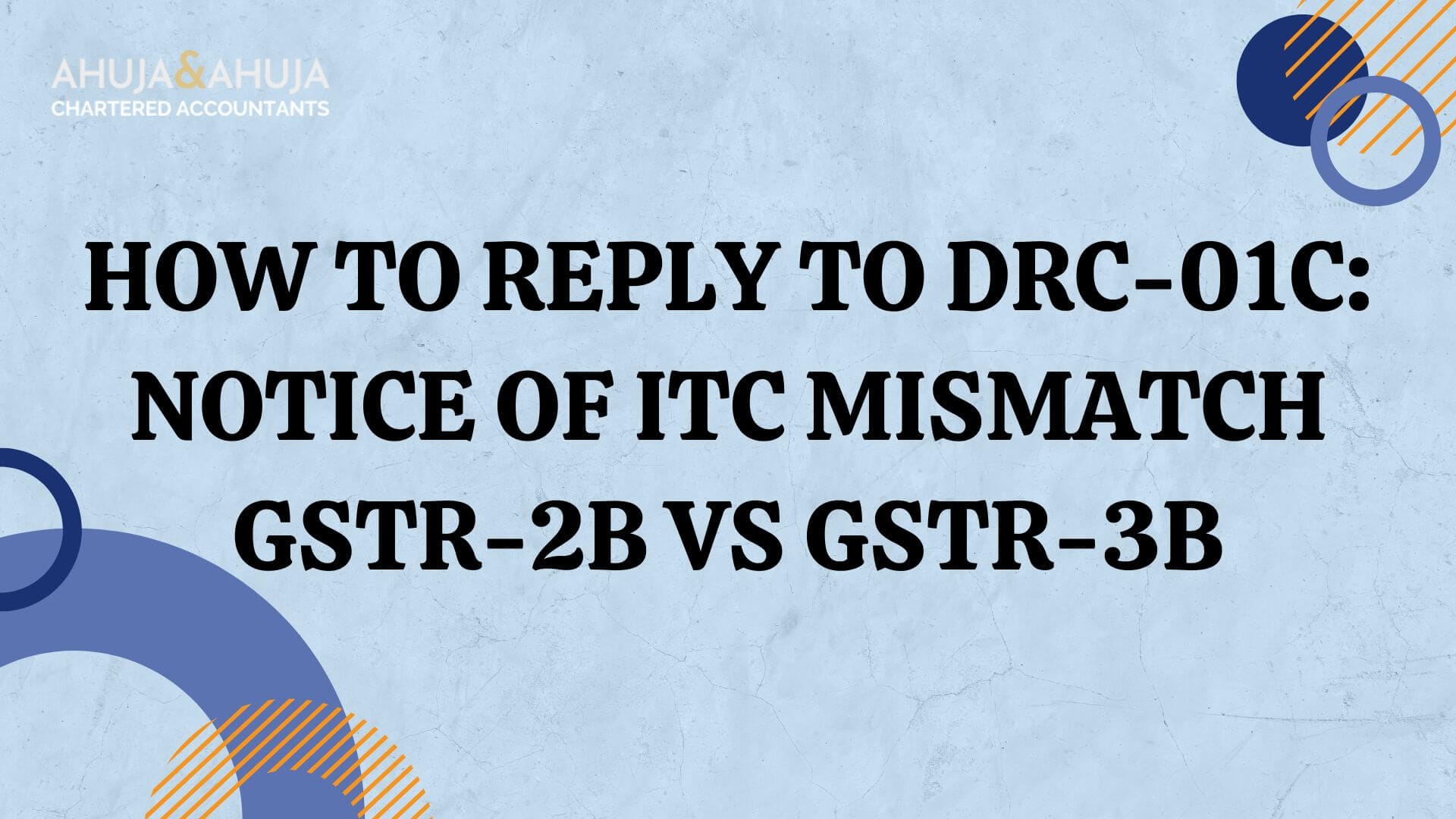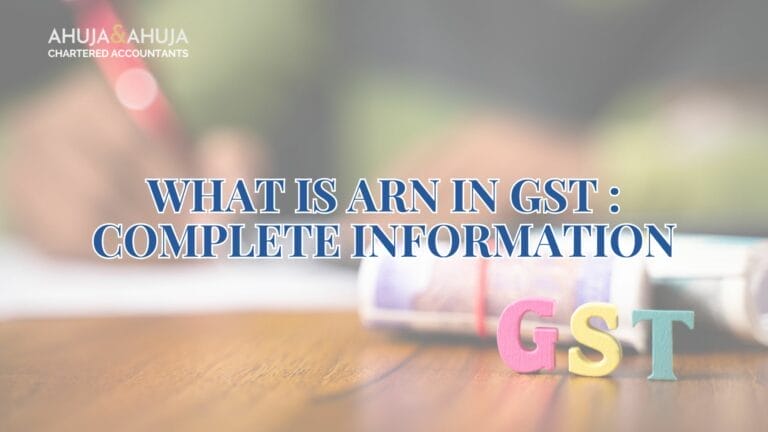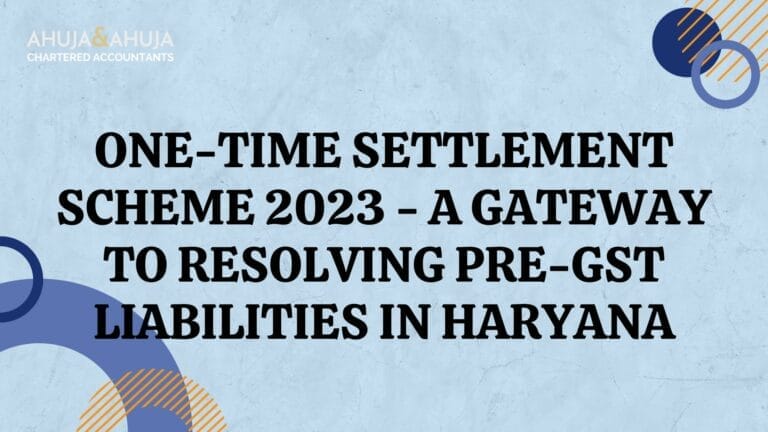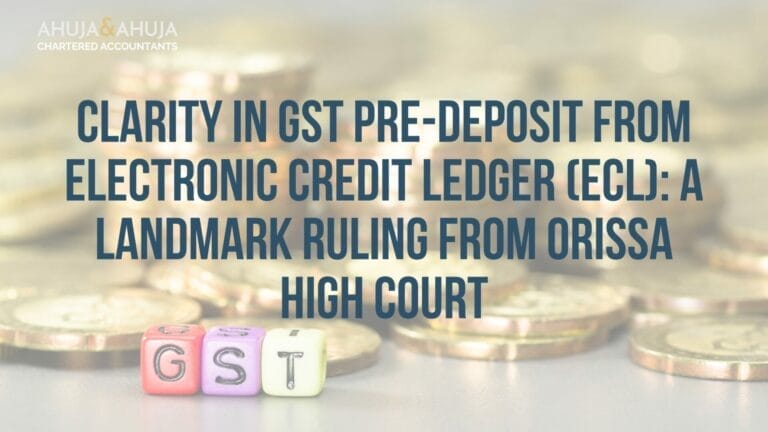How to Reply to DRC-01C: Notice of ITC Mismatch GSTR-2B vs GSTR-3B
Understanding DRC-01C: Notice of ITC Mismatch in GSTR-2B vs GSTR-3B
When operating in the realm of GST in India, maintaining accuracy in the filing of monthly returns, specifically GSTR-1 and GSTR-3B, is imperative.
However, discrepancies between these forms can lead to the receipt of a form known as DRC-01C, a crucial GST document issued under Rule 88D.
This document notifies the taxpayer about the discrepancies in Input Tax Credit (ITC) claims.
In this part of our comprehensive guide, we will delve into the specifics of understanding what a DRC-01C notice involves, why it is issued, and the initial steps you should take upon receiving it.
What is a DRC-01C Notice?
A DRC-01C notice is issued when there is a mismatch in the ITC claimed in GSTR-3B as compared to the auto-populated ITC in GSTR-2B.
This form serves as an intimation asking the taxpayer either to justify the excess ITC claimed or to reconcile and pay the excess amount along with applicable interest.
As per Rule 88D of the CGST Rules, if the availed ITC in GSTR-3B exceeds what is reflected in GSTR-2B by a certain percentage, then this form is automatically generated. The taxpayer is provided with two options:
- Payment of Excess ITC: Pay the amount equivalent to the excess ITC availed, along with interest under Section 50, through FORM GST DRC-03.
- Explanation for ITC Mismatch: Explain the reasons for the mismatch on the common portal within a stipulated time frame.
Why is DRC-01C Issued?
The primary reason for the issuance of a DRC-01C notice is to curb the misuse of ITC and ensure proper tax compliance.
It acts as a preemptive measure to correct discrepancies before they compound into larger tax evasion issues.
The notice helps both the tax authorities and the taxpayers to keep the ITC claims transparent and within the legal frameworks.
Initial Steps Upon Receiving a DRC-01C Notice
Upon receiving this notice, it is crucial not to panic but to proceed methodically:
Document Review: Start by comparing your ITC claims as listed in GSTR-3B with the details in GSTR-2B for the period in question.
Record Gathering: Gather all purchase invoices and other relevant documents that support the ITC claims that have been made.
Reconciliation: Conduct a thorough reconciliation to identify and understand the root cause of any discrepancies.For a step-by-step guide on how to conduct this reconciliation effectively, consider exploring our detailed GST Checklist and Action Points which provides a comprehensive approach to assuring compliance and accuracy in GST returns.
Preparing and Filing Your Response to DRC-01C
Once you have understood the nature of the DRC-01C notice and have completed your initial document review and reconciliation, the next crucial step is to prepare and file your response.
This part of the guide focuses on how to articulate a precise response and navigate the filing process on the GST portal.
Steps to Prepare Your Response
Determine the Nature of the Response:
- If your reconciliation identifies a legitimate excess claim, you must reverse this excess ITC. This is typically done by filing FORM GST DRC-03 where you will declare and pay the excess amount along with applicable interest.
- If the excess is due to legitimate reasons such as delayed invoices or input tax credits from previous periods not declared, you need to prepare a detailed explanation, referencing specific entries and providing supporting documentation.
Document Preparation:
- Gather all supporting documents such as invoices, electronic ledgers, and any correspondence related to the ITC claims.
- Prepare a reconciliation statement that clearly outlines the differences and the reasons for these differences.
Drafting the Response:
- Clearly state whether you are paying the excess ITC or providing an explanation for the difference.
- If explaining, ensure that the explanation is concise, well-documented, and linked to specific line items in your returns.
Filing Your Response on the GST Portal
- Login to the GST Portal:
- Access the GST portal and navigate to the returns dashboard where you can find the link to respond to DRC-01C.
- Response Entry:
- Enter the necessary details in Part B of the FORM DRC-01C. This may include selecting the reason for the discrepancy from a dropdown menu or providing a narrative explanation.
- Attach all necessary documentation, including the reconciliation statement and any other supporting documents.
- Review and Submission:
- Review your entries and documents thoroughly. This is crucial as any errors could lead to further complications or another notice.
- Submit the response. Ensure that you receive a confirmation and a digital receipt of your submission.
If you find this task daunting, seeking professional GST Return Filing Services can be an effective way to ensure that your response to the notice is accurate and timely.
Post-Submission Steps
After filing your response to the DRC-01C notice, it is important to monitor the status through the GST portal. If your explanation is accepted, the matter will be resolved without further action.
However, if the response is deemed unsatisfactory, you might be asked to provide further details or make the necessary payments.
For taxpayers who require continuous tracking of such notifications, considering integrating technology solutions such as E-invoicing and E-waybill generation can streamline compliance and tracking processes.
Responding correctly and promptly to a DRC-01C notice is imperative to avoid any legal issues or penalties. Taking proactive steps to understand the intricacies of the notice, preparing a detailed response, and navigating the GST portal effectively are key to handling this process smoothly.
Stay diligent, organized, and compliant to ensure that your business operations run seamlessly with respect to GST regulations.
Minimising the Risk of Receiving a DRC-01C Notice
To prevent the recurrence of receiving a DRC-01C notice for ITC mismatches, it is crucial to incorporate robust compliance checks and balances within your accounting processes.
This part of our series will outline strategies and practices to help minimize discrepancies between GSTR-2B and GSTR-3B, thus reducing the likelihood of facing such notices.
Effective Strategies to Avoid ITC Mismatches
- Regular Reconciliation:
- Conduct monthly reconciliations of your GSTR-2B against your purchase registers and GSTR-3B entries. This helps in catching discrepancies early and correcting them before the submission of the returns.
- Utilize automated software tools that can help in tracking and reconciling transactions efficiently.
- Accurate Record Keeping:
- Ensure that all invoices and transaction records are accurately recorded and archived. Discrepancies often arise from clerical errors, so meticulous documentation is key.
- Implement double-check systems where entries are reviewed by multiple individuals or departments to ensure accuracy.
- Timely Return Filing:
- Avoid last-minute filings. By planning and preparing your returns well before the deadline, you allow ample time for review and corrections if necessary.
- Keep abreast of all deadlines and changes in GST compliance regulations to ensure timely compliance.
- Training and Awareness:
- Regularly train your accounting and finance teams on GST regulations and updates. Understanding the intricacies of GST rules, including ITC claims, is crucial.
- Participate in GST workshops and seminars to stay informed about best practices and insights from industry experts.
Technological Integration
Leveraging technology can significantly streamline the process of managing GST returns and ensuring accuracy:
- GST Compliance Software: These platforms can automate much of the reconciliation process, highlight mismatches promptly, and offer actionable insights to resolve issues.
- E-Invoicing Solutions: As compliance norms evolve, integrating E-invoice generation with E-waybill systems can help ensure that all taxable transactions are recorded in real time and accurately reflected in periodic returns.
Regular Compliance Audits
- Schedule quarterly or bi-annual audits to review all GST filings and related processes.
- Use these audits to identify not just errors but also areas for improvement in process efficiency and compliance adherence.
Proactively managing your GST compliance by implementing the strategies outlined can significantly reduce the likelihood of discrepancies leading to DRC-01C notices.
Learning and Continuous Improvement from DRC-01C Experiences
Despite implementing robust systems and procedures to minimize ITC mismatches, receiving a DRC-01C notice can still occur.
This final part of our series focuses on turning such experiences into learning opportunities for continuous improvement in GST compliance processes.
Analyzing the Incident
- Comprehensive Review:
- Once a DRC-01C notice is resolved, conduct a detailed review to understand what led to the discrepancy. Was it a systemic error, a one-time oversight, or a misunderstanding of GST regulations?
- Analyze the steps taken to resolve the notice to identify any inefficiencies or areas for process enhancement.
- Feedback Loop:
- Involve the team members who handle GST filings and ITC claims in the review process. Their firsthand insights can provide valuable feedback on what might be improved to prevent future occurrences.
- Consider implementing a feedback mechanism where employees can report potential discrepancies or confusions without repercussions.
Improving Processes and Policies
- Policy Updates:
- Based on the insights gained from the review, update your GST compliance policies and procedures as necessary to fortify against similar issues.
- Ensure that all policy updates are well-documented and communicated across your organization.
- Enhanced Training Programs:
- Develop targeted training modules that address the specific issues encountered. This helps in building competency and confidence among employees handling GST-related tasks.
- Consider periodic refresher training sessions to keep all relevant team members up to date on the latest GST rules and best practices.
- Leveraging Technology for Compliance:
- Invest in advanced GST software tools that offer not just automation but also predictive analytics to foresee potential mismatches or errors before they occur.
- Regularly update your systems to align with the latest GST regulations and technological advancements.
Cultivating a Culture of Compliance
- Promote Transparency:
- Encourage an open environment where issues can be discussed freely. This can lead to proactive identification of potential risks and collaborative problem-solving.
- Recognize and reward compliance and process improvement initiatives within your team.
- Regular Audits and Reviews:
- Establish a routine of regular internal audits dedicated to GST processes to ensure continuous adherence to compliance standards.
- Use external audits as an opportunity to gain an unbiased evaluation of your GST compliance status and areas for further improvement.
Conclusion
Receiving a DRC-01C notice should not just be viewed as a challenge but as an opportunity to improve and refine your GST compliance strategies.
Each incident provides a unique learning opportunity, contributing to a stronger, more efficient compliance framework.
By adopting a proactive and continuous improvement approach, you can enhance your organization’s resilience against compliance issues and foster a more compliant and aware organizational culture.
Through this, your company can ensure smoother operations and better preparedness for any GST-related hurdles in the future.
Disclaimer
The materials provided herein are solely for educational and informational purposes. No attorney/professional-client relationship is created when you access or use the site or the materials. The information presented on this site does not constitute legal or professional advice and should not be relied upon for such purposes or used as a substitute for professional or legal advice.







